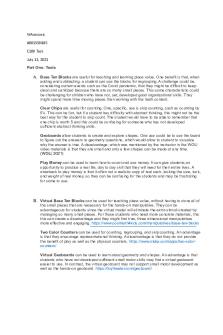C109 Task 1 wgu.edu PDF

| Title | C109 Task 1 wgu.edu |
|---|---|
| Course | Instructional Strategies and Technologies for Elementary Learners with Mild to Moderate Exceptionalities |
| Institution | Western Governors University |
| Pages | 8 |
| File Size | 224.8 KB |
| File Type | |
| Total Downloads | 2 |
| Total Views | 191 |
Summary
Instructional Strategies and Technologies for Elementary Learners with Mild to Moderate Exceptionalities D006...
Description
A. 1. two-colored counters -
-
A use of this tool is that they can help students explore things like addition, subtraction, multiplication and division. A benefit of using this tool is that it provides a visual context when exploring some sort of math concepts like adding or subtracting or multiplying and dividing integers and help develop the skill of cardinality or one to one correspondence. A challenge of using the two-colored counters is that they are not ideal for displaying large integers.
2. The Base Ten Blocks -
A use of base ten blocks to is explore concepts related to place value, addition, subtraction, multiplication and division A benefit of using the base ten blocks is that it helps students organize their thought process and can teach students regrouping using visual context A challenge of using the base ten blocks is that it may be take a long time to lay out very large manipulatives and their may not physically be enough pieces for all of the students
3. The Cuisenaire rods -
A use of the Cuisenaire rods is that they are almost exclusively used for fractions and helps find common denominators
-
A benefit of using the tool to is that they provide a very high conceptual understanding and help students visualize the fraction process (Acrobatiq,2021).
-
A challenge of using the Cuisenaire is that they are limited in denomination,
4. Calculator - A use of the calculator is that it can be given to students to conceptualize different patterns or to explore a specific lesson such as perimeter -
A benefit of using the calculator is that in a discovery based lesson or pattern based recognition lesson students are encouraged explore math concepts or see patterns
-
One challenge of using the calculators is that students can become reliant on them over time rather than doing computations on their own
B. 1. Virtual Fraction Tiles -
A use of virtual fraction tiles can be to explore concepts such as fractions and common denominators
-
A benefit of using the virtual fraction tiles to concepts is that it can help students add fractions and find common denominators
-
A specific challenge of using virtual fraction tiles to explore mathematical concepts is that all of the values that a student may need in a denominator may not be shown on the screen. Which can be a potential challenge when students are adding or multiplying fractions
https://www.didax.com/apps/fraction-number-line/ 2. virtual geoboards -
A use of the virtual geoboards is that they can be used in the classroom to introduce geometric shapes A specific benefit of using the tool is that students can create their own shapes while exploring concepts of geometry A specific challenge of using the virtual geoboards is that students may become distracted and go off task to play rather than explore math concepts
https://www.didax.com/apps/geoboard/ 3. Money Pieces App. -
A use of the Money Pieces App to explore mathematical concepts is to help students learn the value of coin and paper money A specific benefit of using the tool to explore mathematical concepts is that students can virtually see all of the coins in the country without having to collect or pass out real money A specific challenge of using virtual geoboards to explore mathematical concepts is that students may miss out on the hands on connection with handling money
https://apps.mathlearningcenter.org/money-pieces/ 4. virtual number lines -
A use of the virtual number line to explore mathematical concepts is to assist in teaching addition and subtraction A specific benefit for using virtual number lines to explore mathematical concepts is that students can visualize how far the difference between two numbers is A specific challenge for using virtual number lines to explore mathematical concepts is that there is often no way to use these for any form of formative assessment as students may erase their progress.
https://www.didax.com/apps/number-line/
Part Two: Lesson Plan C. Direct Instruction Lesson Plan Template General Information Lesson Title: Learning Place Value
Subject(s): Math: Numbers and Place Value Grade/Level/Setting: 1st grade Prerequisite Skills/Prior Knowledge: Students will need to already know -
representing, relating and operating on whole numbers Understand addition as putting together and adding to and understand subtraction as taking apart and taking from Work with numbers 11-19 to base foundations for place value
Standards and Objectives State/National Academic Standard(s): OH.1.NBT.2 Understand that the two digits of a two-digit number represent amounts of tens and ones http://education.ohio.gov/getattachment/Topics/Learning-in-Ohio/Mathematics/Ohio-s-Learning-Standards-inMathematics/MATH-Standards-2017.pdf.aspx?lang=en-US Learning Objective(s): When using base ten blocks, students will be able to demonstrate their ability to count two-digit quantities and use whole numbers to construct groupings of tens and ones and answer 80% of the questions correctly Materials -
Hands on tool : Base ten blocks Place Value worksheet Place Value Chart
Technology -
Personal FM systems for students SMART Board Ones, Tens, and Hundreds song on youtube
https://www.youtube.com/watch?v=a4FXl4zb3E4 https://www.teacherspayteachers.com/Product/Place-ValueWorksheets-First-Grade-Tens-and-Ones-4428691
https://www.teacherspayteachers.com/Product/Anchor-ChartPlanogram-Vol-1-Place-Value-3254640? st=2a134ca7e0117f4a971317624ec4c632 Language Demands Language Function(s): Students will use academic language to know the value and names of two digit numbers.
Vocabulary: Ones, tens, quantity, number, numerals, two-digit numbers, base ten blocks Discourse and/or Syntax: Students will first participate in a whole group discussion as the teacher pulls from their prior knowledge, introduces the lesson plan, models how to utilize their base ten block manipulatives, works through practice problems with the class, and the class will listen to the Ones, Tens and Hundreds video. During independent practice, the teacher will walk around the room and talk to students individually having students break down two digit numbers in their place value charts with their base- ten blocks and check for understanding by asking students to explain their thinking while they solve the problems Once students finish their work, the teacher will call upon students who raise their hands to answer additional place value problems to check for understanding with the class Planned Language Supports: The planned language supports within this lesson include the use of base-ten blocks, the Ones, tens and hundreds video, the new vocabulary. Students will utilize the base ten blocks throughout the lesson plan, first observing the teacher model their function and application, then by practicing a few problems on their own with guidance from the teacher. Instructional Strategies and Learning Tasks
Anticipatory Set: Activity Description/Teacher -
Student Actions -
The teacher will introduce the lesson by having students review numbers in the teens to activate prior knowledge of each number being 10 with some left over. For example, 19 being 10 with 9 left over.
Students will review teen numbers to activate prior knowledge through direct instruction with the teacher
Presentation Procedures for New Information and/or Modeling: Activity Description/Teacher -
-
The teacher will bring up the Ones, Tens and Hundreds video for the students to watch and bring out the base ten blocks for the students to observe and explore Teacher will review new vocabulary and its meaning
Student Actions -
Students will watch the Ones, Tens, and Hundreds video and begin exploring the use of Base-ten blocks Students will review new vocabulary
Guided Practice: Activity Description/Teacher -
The teacher will begin by modeling the base ten blocks for the class, explaining that base ten blocks are pregrouped models matched with individual units that students can use to help us when breaking down larger two-digit numbers into groups before demonstrating for the class how to utilize the
Student Actions -
-
Students will watch the teacher model the base-ten blocks for them while exploring their own blocks, to learn how to break down two digit numbers Students will write and breakdown two digit numbers in their place value chart as the teacher walks around the room to check for understanding with individual
-
manipulatives to separate two-digit numbers into groups of tens and ones by breaking down several sets of numbers, while showing students how to break down two- digit numbers The teacher will have students break down two digit numbers in their place value charts and check for understanding
students
Independent Student Practice: Activity Description/Teacher -
-
-
The teacher will give all students a set of two digit numbers to solve on their own using the base-ten blocks for practice The teacher will go around the room to ask students individually during independent practice to demonstrate their learning with the base ten blocks After students are able to demonstrate understanding with the base ten blocks the teacher will pass out the place value worksheet for students to work on for the remainder of the class period
Student Actions -
-
Students will independently start to solve place value problems Students use the base-ten blocks to apply knowledge that was learned in the lesson to break down twodigit problems into groups of tens and ones. This hands-on activity helps students solidify knowledge by using visual and kinesthetic learning to gain conceptual understanding. Students will begin working on their place value worksheets
Culminating or Closing Procedure/Activity: Activity Description/Teacher -
-
Before the end of the class period students will turn in their place value worksheets along with their base-ten blocks Once all students have turned in their worksheets the teacher will gauge effectiveness by having students raise their hands to determine place value of numbers written on the board until the end of class
Student Actions -
Students will turn in place value worksheets and base-ten blocks. Students raise their hands to determine place value of numbers written on the board until the end of class
Differentiated Instruction . Gifted and Talented: Gifted and talented students will use the base ten block to determine place value of three digit numbers rather than two digit numbers. EL: English Language Learners will have worksheets written in their native language and have access to the Ones, Tens and Hundreds video in their native language. Students with Other Special Needs: Students with hearing impairments will use personal Fm systems to better hear the teacher.
Assessment Formative After extending student thinking by demonstrating for the class how to utilize the manipulatives to separate two-digit numbers into groups of tens and ones by breaking down several sets of numbers, while supporting students by showing them how to break down two- digit numbers. The teacher will have students break down two digit numbers in their place value charts and check for understanding and to monitor student progress with individual students using the base-ten blocks. Progress will also be monitored with an informal assessment at the end of the class period by having students raise their hands to answer place value questions. Summative After guided practice and students are able to demonstrate understanding with the base ten blocks the teacher will pass out the place value worksheet for students to work on for the remainder of the class period and turn in these worksheets at the end of the class period for summative assessment
Part Three: Reflection. D. Base-ten blocks help enhance student learning during the lesson by to explore mathematical concepts related to place value, addition, subtraction, multiplication and division. Base-ten blocks helps students organize their thought process and can teach students regrouping using visual context and help student facilitate a deeper understanding and better comprehension of place value and the tens place and ones place. E. 1. conceptual understanding Conceptual Understanding can be demonstrated in this lesson as students use the base-ten blocks to apply knowledge that was learned in the lesson to break down two-digit problems into groups of tens and ones. This hands-on activity helps students solidify knowledge by using visual and kinesthetic learning to gain conceptual understanding. 2. problem solving Problem solving is incorporated into several parts of this lesson plan as students break down two digit numbers given by the teacher during in their place value charts during guided practice. Also, when students receive a set of two digit numbers to solve on their own using the base-ten blocks to practice. Finally using the place value worksheets, students will problem solve to find out what base-ten blocks add up to and correctly identify the tens and ones place for each problem 3. procedural fluency Procedural Fluency will be demonstrated in this lesson by students being individually monitored by the the teacher having students break down two digit numbers in their place value charts and check for understanding by asking students to explain their thinking while they solve the problems.
F. Discovery learning in this lesson supports learning outcomes by the students using the base-ten blocks and a constructivist based approach to help support their learning with their problem solving when it comes to two-digit numbers. By providing a visual and hands-on learning to build upon prior knowledge. G. Resources Ohio Department of Education. (2021). Ohio Learning Standards: Mathematics. Retrieved 14 July 2021, from http://education.ohio.gov/getattachment/Topics/Learning-in-Ohio/Mathematics/Ohio-sLearning-Standards-in-Mathematics/MATH-Standards-2017.pdf.aspx?lang=en-US Western Governors University. Acrobatiq. (2021). Tools and Manipluatives. Retrieved 12 July 2021,from https: // wgunx.acrobatiq.com/enus/courseware/page/ wgu_C109_01Jul20_ Elem_ Math_ Meth_v2_1 / tools_for_mathematics
Center, T. (2021). Money Pieces by The Math Learning Center. Retrieved 12 July 2021, from https://apps.mathlearningcenter.org/money-pieces/
n.a. (2021). Fraction Tiles. Retrieved 12 July 2021, from https://www.didax.com/apps/fractionnumber-line/ n.a. (2021). Number Line. Retrieved 12 July 2021, from https://www.didax.com/apps/numberline/ n.a. (2021). GeoBoard.. Retrieved 12 July 2021, from https://www.didax.com/apps/geoboard/
Amy Growsbeck. (2021). Place Value Anchor Chart. Teachers Pay Teachers. Retrieved 13 July 2021, from https://www.teacherspayteachers.com/Product/Anchor-Chart-Planogram-Vol-1-Place-Value3254640?st=2a134ca7e0117f4a971317624ec4c632
Melicety. (2021). Place Value Worksheets First Grade Tens and Ones. Teachers Pay Teachers. Retrieved 13 July 2021, from https://www.teacherspayteachers.com/Product/Place-Value-WorksheetsFirst-Grade-Tens-and-Ones-4428691...
Similar Free PDFs

C109 Task 1 - C109 Task 1
- 5 Pages
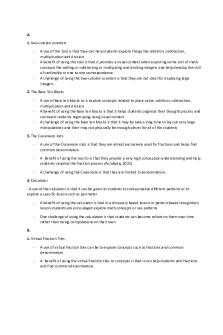
C109 Task 1 wgu.edu
- 8 Pages

C109 Math Methods Task 1
- 6 Pages
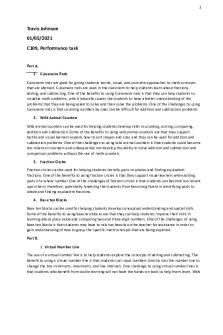
C109 performance task
- 10 Pages
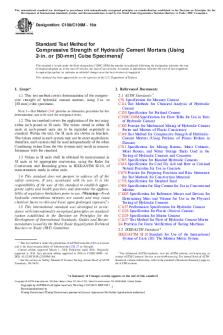
ASTM C109 - ASTM C109
- 10 Pages

PCE Task 1 - Task 1
- 2 Pages

Task 1 - SUS101 Task 1
- 2 Pages

Qht1 task 1 - Task 1
- 3 Pages

QBM1 Task 1 - Task 1
- 5 Pages
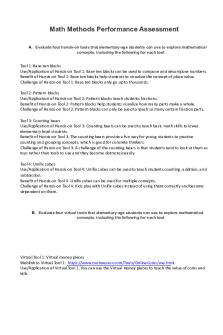
C109-2 - TASK2
- 10 Pages

C365 - Task 1 - Task 1
- 4 Pages

Task 1 - C226 Task 1
- 11 Pages

C304 Task 1 - TASK 1
- 16 Pages

DIT1 TASK 1 - Task 1
- 4 Pages
Popular Institutions
- Tinajero National High School - Annex
- Politeknik Caltex Riau
- Yokohama City University
- SGT University
- University of Al-Qadisiyah
- Divine Word College of Vigan
- Techniek College Rotterdam
- Universidade de Santiago
- Universiti Teknologi MARA Cawangan Johor Kampus Pasir Gudang
- Poltekkes Kemenkes Yogyakarta
- Baguio City National High School
- Colegio san marcos
- preparatoria uno
- Centro de Bachillerato Tecnológico Industrial y de Servicios No. 107
- Dalian Maritime University
- Quang Trung Secondary School
- Colegio Tecnológico en Informática
- Corporación Regional de Educación Superior
- Grupo CEDVA
- Dar Al Uloom University
- Centro de Estudios Preuniversitarios de la Universidad Nacional de Ingeniería
- 上智大学
- Aakash International School, Nuna Majara
- San Felipe Neri Catholic School
- Kang Chiao International School - New Taipei City
- Misamis Occidental National High School
- Institución Educativa Escuela Normal Juan Ladrilleros
- Kolehiyo ng Pantukan
- Batanes State College
- Instituto Continental
- Sekolah Menengah Kejuruan Kesehatan Kaltara (Tarakan)
- Colegio de La Inmaculada Concepcion - Cebu

